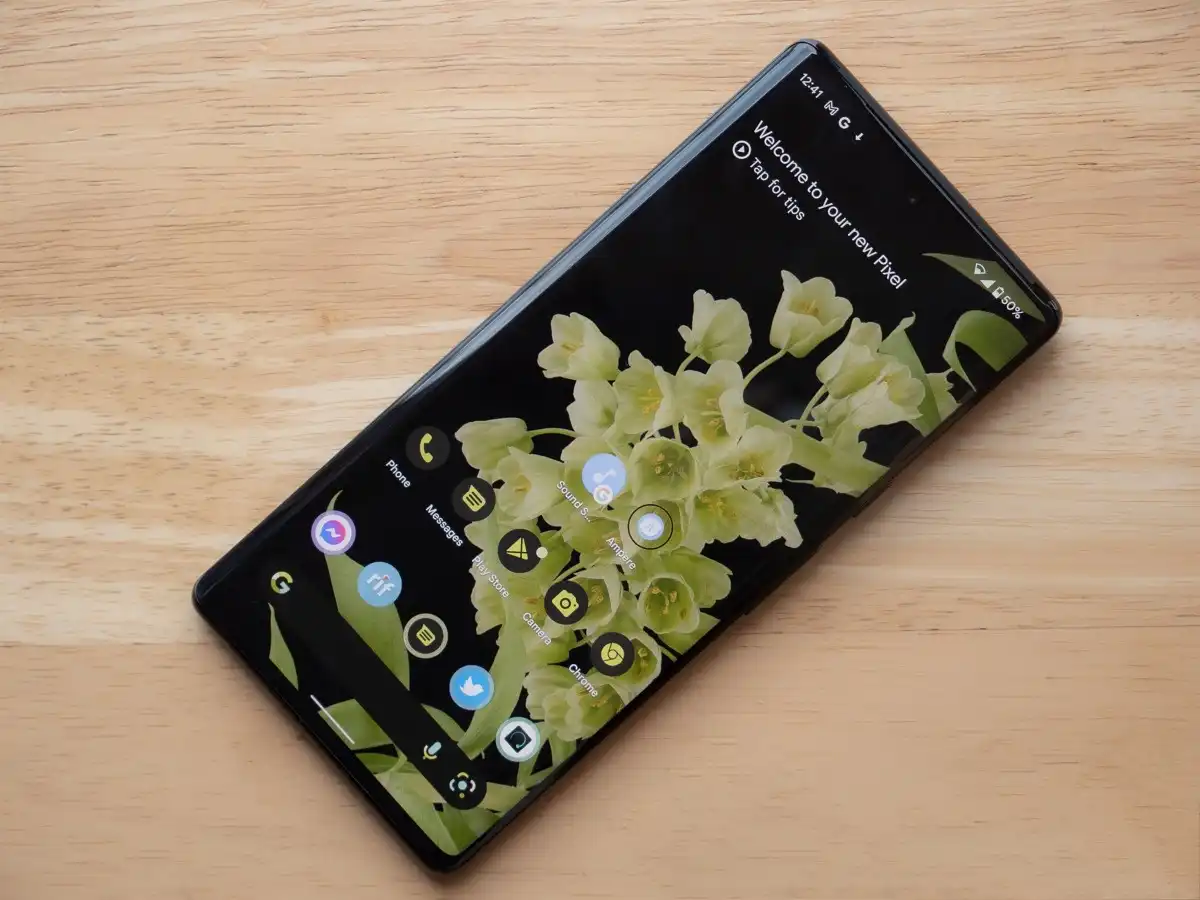The Google Pixel 6 Pro is the most beautiful Pixel smartphone ever. It was released as part of the Google Pixel 6 series with the Google Tensor chipset developed by Google. It also debuted the latest and greatest version of Android, Android 12. Google Tensor marks the company’s debut in smartphone chips, and the Google Pixel 6 Pro packs all the Google benefits you’ve come to expect from a Pixel. Machine learning-powered features, clean software, and fast updates – it’s all there.
The most interesting part of this device for me is Google Tensor, and I think many people think the same. Last year’s Pixel 5 with the Qualcomm Snapdragon 765G chipset left a sour taste in the mouth of many people, many said it wasn’t good enough for a flagship smartphone. Tensor, being a brand new chipset, is at the same time incomparable and comparable to other processors, even though the company has already stated that it is not benchmarking.
Better yet, the Pixel 6 Pro has a camera update for the first time in a long, long time. Since the days of the Google Pixel 2, Google has stuck with the same IMX362 / IMX363 camera and the sensor has begun to show its age compared to the latest flagship smartphones. The Pixel 6 Pro has a 50MP Samsung GN1 sensor, and it’s much better than anything Google has done before.
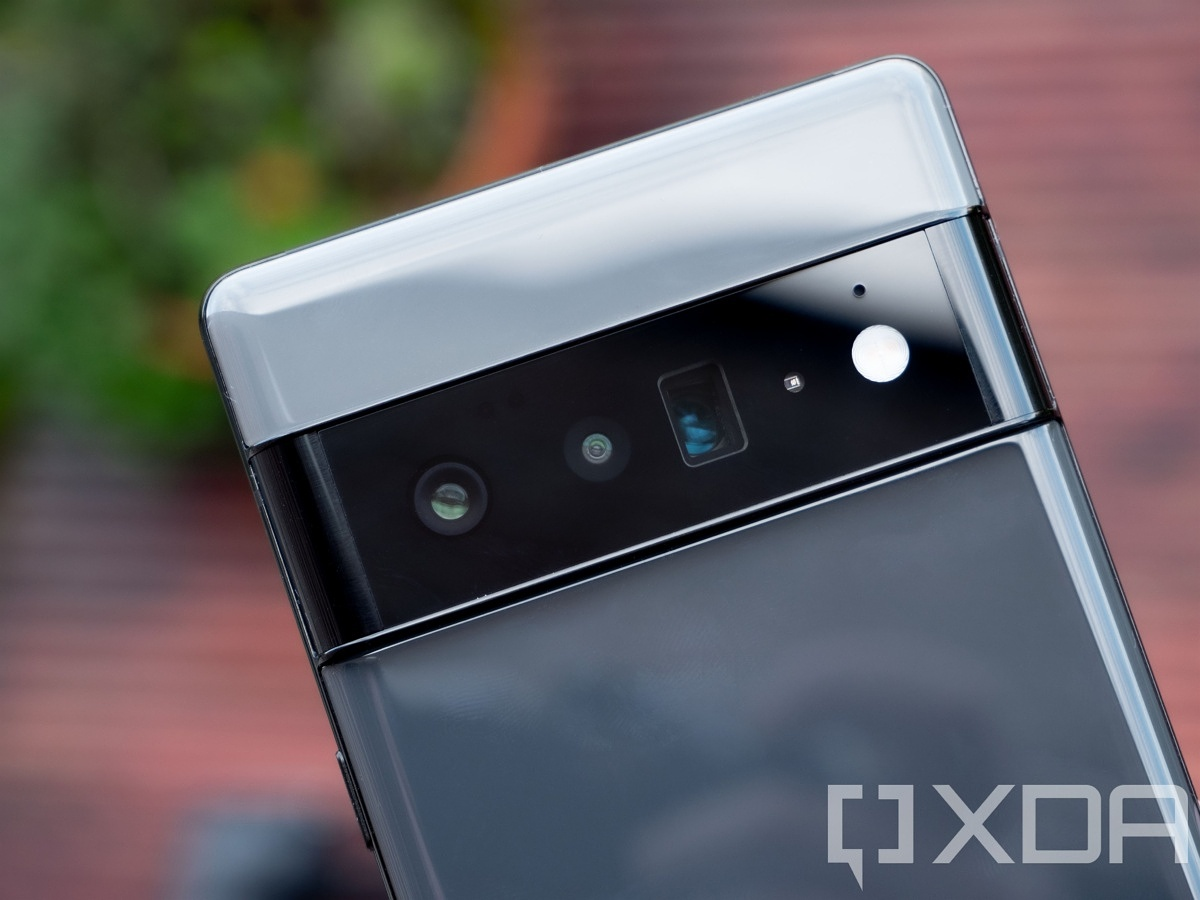
About this review: Adam Conway received the Google Pixel 6 Pro for review for IrishTech from Google Ireland on October 20, 2021. Google was not involved in any way in the preparation of this article.
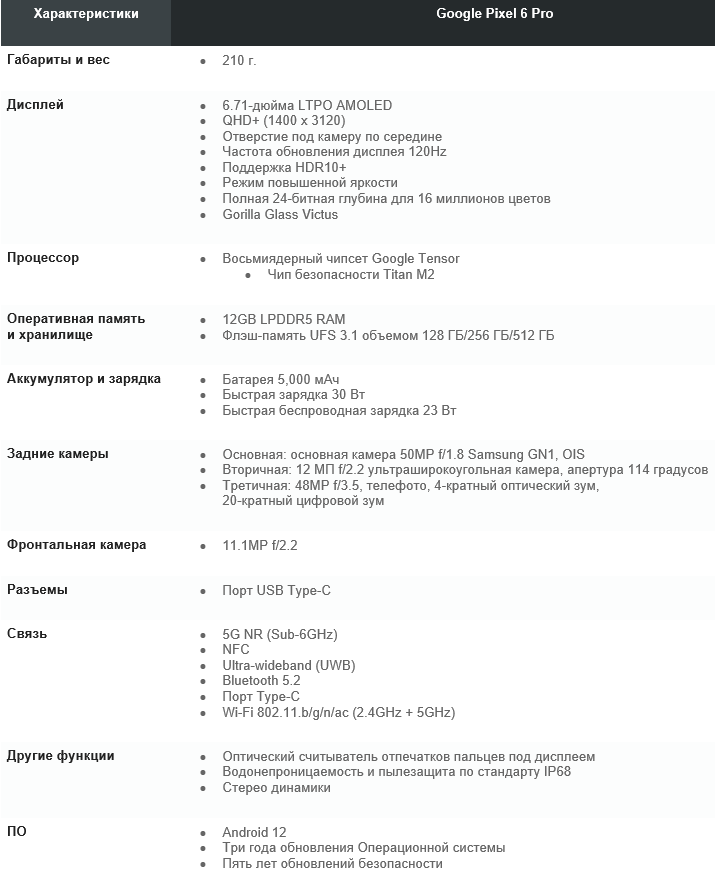
Google Pixel 6 Pro: Design

The Google Pixel 6 Pro has a pretty unique design and the rear camera visor stands out from the competition. It houses the main camera Samsung GN1 with a resolution of 50 megapixels, an ultra-wide-angle camera with a resolution of 12 megapixels and a telephoto camera with a resolution of 48 megapixels. There are also other important elements of the camera, such as the microphone and flash. Note: Compared to other phones with a large camera block on one side, I prefer the Pixel 6’s camera bump option as it runs all over the device, which means it won’t wobble on the table when in use. It also looks like the visor on Daft Punk’s Thomas Bangalter helmet, which is pretty cool.
The display is curved and the phone itself is thick, making it rather bulky to hold in one hand. Plus, it’s quite slippery, and the Stormy Black we had is very fingerprint-pulling. I would definitely recommend getting some kind of case for it, as this phone is difficult to hold in your hands. The back panel of the Stormy Black is two-tone, with the top of the device above the camera visor being a lighter gray than the one below.
Thanks to the uniform bezel, the front of the phone, with the exception of the front camera, remains free, so it is pleasant to use and look at it. Its design is somewhat boxy at the top and bottom, and reminds (at least to me) of some older Samsung Galaxy Note devices. I think part of that feeling comes from the square bezel at the top and bottom, and I really, really like the way it looks as a result.
The top of the display also houses the speaker grill, which serves as both a spoken and stereo speaker. The earpiece is great for making calls, although the sound comes out upward rather than outward. This means that I need to tilt my phone slightly in order to hear the other person clearly, although this is not so important, and I quickly got used to it. The speakers themselves sound pretty good and they are quite loud.
I’m a big fan of the Pixel 6 Pro’s camera design, and it definitely echoes the patterned glass slab we see every year. I don’t really care about camera protrusions, but I know that a lot of people do, and this option is perfect for a smartphone. It is large, but not much thicker than other offerings from other companies.
The buttons are tactile and easy to press, although I’m a little disappointed that the power button no longer has a cool and unique color. The location of the buttons is also somewhat odd – the power button sits above the volume rocker, which makes the screenshot a little awkward. The SIM tray is also on the left side, while the USB-C port is at the bottom, next to the speaker grill.
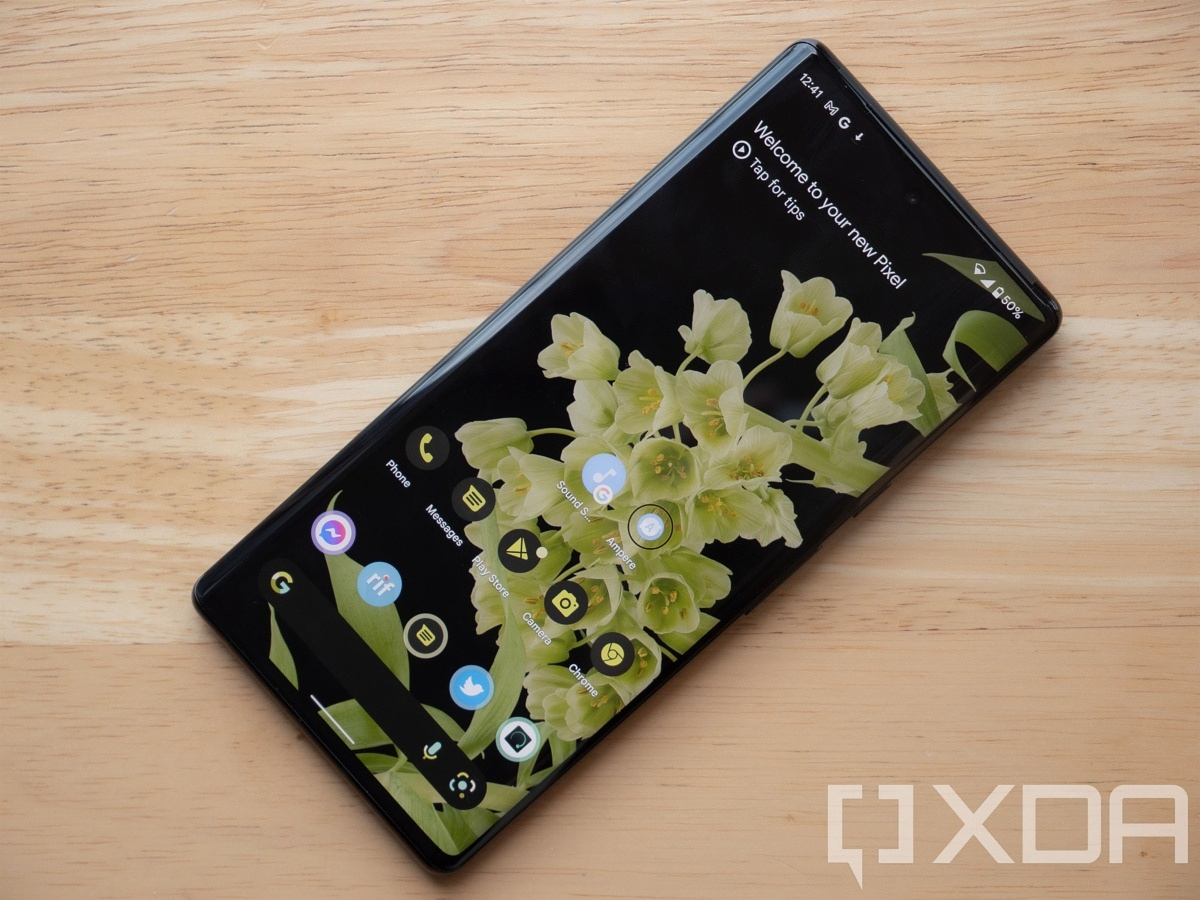
The Google Pixel 6 Pro features a 6.71-inch curved OLED LTPO display with a 120Hz refresh rate, interrupted only by a camera with a hole at the top in the middle. The hole is not too big, so you won’t notice it during normal use. The Pixel 6 Pro’s screen is pretty bright, up to 800 nits with auto brightness on, and more than usable on a bright Irish day. However, it should be noted: A bright Irish day is still significantly darker than most bright days in other countries.
To be honest, I don’t think this will be a problem on bright days. I would have liked it to be a little brighter by just sitting indoors, but that’s not the main complaint, and it is clearly visible in direct sunlight, which is most important. On the other hand, the Pixel 6 Pro’s display can also get very dark – perfect for using your phone in dark rooms or at night! There is also an “Extra Brightness Down” option if the minimum display brightness is not low enough for you.
In terms of tactile vibration feedback, here’s the best tactile experience I’ve had in Android phones, and almost on par with the iPhone 13 Pro, which I’ve also been using lately. The under-display fingerprint sensor is accurate and fast. Its incredible tactile feedback makes it easy to find when you’re not looking at your phone and want to unlock it.
Google Pixel 6 Pro: Camera
If Pixel smartphones are universally recognized for a feature, it is certainly because of their cameras. Google has been using more or less the same camera hardware for several years in a row, and the Pixel 6 series is a significant departure from that comfort zone. The company switched to the Samsung GN1 sensor, ditching the IMX363, which has been a staple at Google for many years. Google’s photographic capabilities on the Pixel 5 were among the best in the business, although the sensor did show its age in low light and in imperfect scenarios. With the upgrade to a larger and better sensor, Google is poised to try to take the throne again. The Pixel 6 Pro was a pleasure to use in almost every situation I encountered,
If the Samsung GN1 camera sensor sounds familiar to you, it’s because it’s used in the Vivo X70 Pro Plus camera. Considering how amazing some of the photos taken by the Vivo X70 Pro Plus have been, we know how capable this sensor is. It has a size of 1 / 1.31 inches, a pixel size of 1.2 microns, an aperture of f / 1.85 and an angle of view of 82 degrees. Google also uses Quad-Bayer (a method of placing Bayer filters to cover not individual pixels, but cells of four light-sensitive elements ) combining the pixels in this camera, which gives a real resolution of 12.5 MP. In the camera app, as far as I can tell, there is no option to take a photo with a high resolution of 50MP.
As for the telephoto camera, it is a 48MP periscope that provides 4x optical and 20x digital zoom. The regular Google Pixel 6 variant lacks a telephoto lens and instead uses Super Res Zoom on the main sensor for 7x zoom.
The only thing that bothers me about the camera is the same problem that bothered me on all Pixel smartphones. It’s the fact that there is no dedicated gallery app – you have to use Google Photos instead. Google Photos seems pretty overwhelming for quickly reviewing the photos I just took, so I found it necessary to install a third-party gallery app. Although I understand that I may be in the minority, so if you are used to the Google Photos app, then you will not have any problems with it on the Pixel 6.
The Google Pixel 6 Pro’s camera is vastly improved over the Pixel 5, but it still has a number of issues that I hope the company will address. For example, it is impossible to take astrophotography with an ultra wide-angle camera or telephoto, and you cannot shoot at 4K 60 FPS on anything other than the main sensor. Both additional cameras can shoot at 4K 30 FPS or lower. Unfortunately, the ultra wide-angle camera also lacks autofocus, but it works very quickly on the main sensor. In addition, in many photographs where there is a light source, there are rather strong lens flares, and autofocus sometimes does not work without pressing the screen.
Google Pixel 6 Pro: Main camera
Link to the photo album made on the main module (flickr.com)
The Google Pixel 6 Pro has a fantastically functional main sensor, although, as mentioned, it has lens flare issues with other light sources. The “point and shoot” ability of the camera is unmatched in my testing on other devices, as I can quickly double-press the power button and take a picture within two seconds if the autofocus is working properly. In most cases, this is the case, but there were times when I had to click on the screen before I had time to take a picture.
Google Pixel 6 Pro: 4x telephoto
Link to photo album taken with 4x telephoto module (flickr.com)
The Google Pixel 6 Pro’s 4x telephoto camera is clearly much, much better than the one that came with the Pixel 5. The Pixel 5 used a proprietary Super Res Zoom feature for 2x zoom photos, even though it didn’t have a real telephoto camera … While the results were decent considering the phone didn’t actually have a TV camera, the Pixel 6 Pro’s telephoto lens is much, much better. I was really impressed with some of the pictures I got on the above album.
Google Pixel 6 Pro: Sample Videos
The Google Pixel 6 Pro does a great job of shooting video and noticeably improves the quality of night shooting thanks to the company’s HDRnet algorithm. Videos may look fuzzy and imperfect at times, but the quality is vastly superior to that of the Pixel 5. However, if you really need a smartphone to shoot video, then I would wait and see if the company releases a software update before deciding to do so. … Everything is fine and works well most of the time, but switching between scales can be jerky. The sound also occasionally crackles, although the sound quality is quite good when not.
Google Tensor and Performance
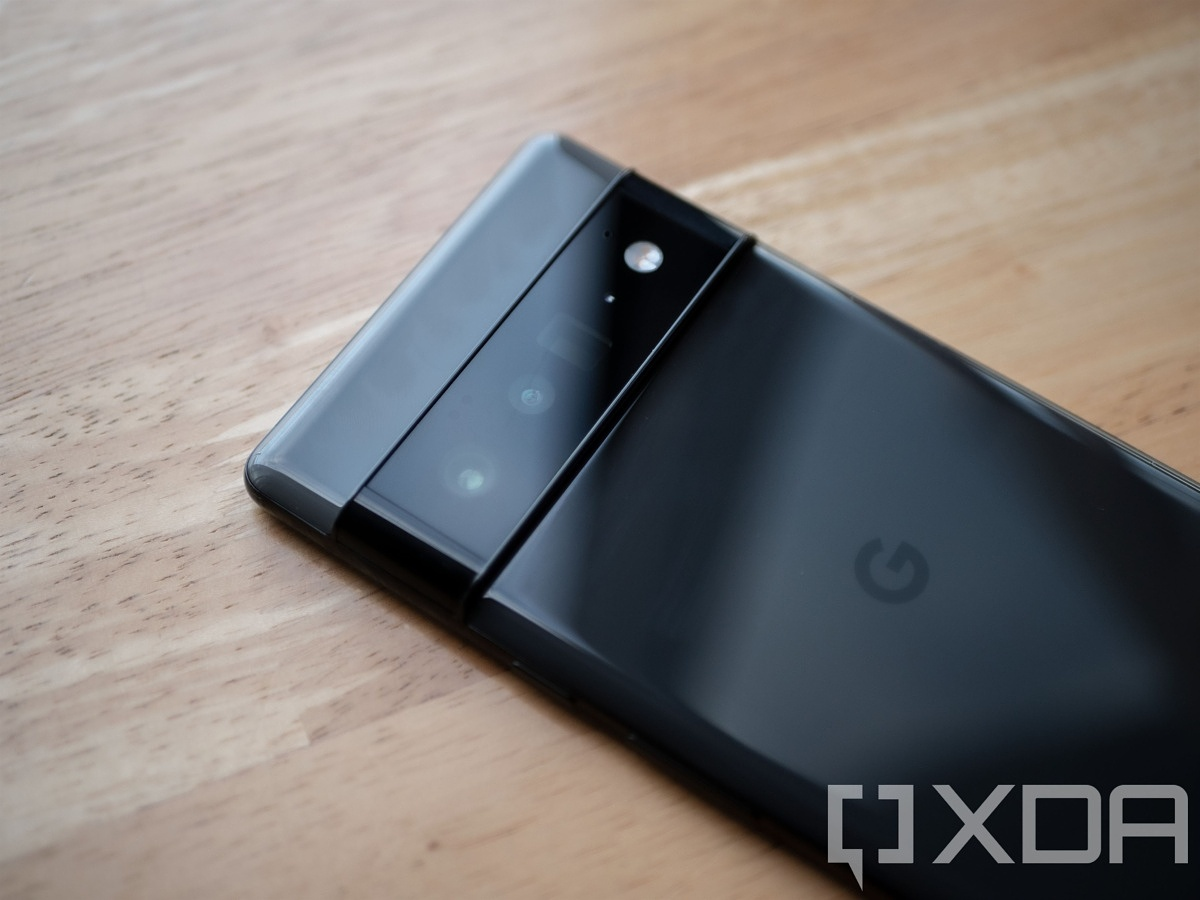
Google Tensor is the company’s first proprietary mobile chipset built specifically for the Google Pixel 6 Pro. It is known that Google has created its own chipsets before when the ones on the market did not meet the requirements. Even YouTube runs on some custom Google chips, and the company calls them “VCU” – Video (trans) Coding Unit. In announcing the Pixel 6 series, Google said that when it came to mobile AI processing, it “held back” for years from what it wanted to do. In an interview with Ars Technica “Google Silicon”, the mobile chip group at Google, more or less confirmed this position .
“Open the camera and you can see in real time a lot of really interesting things happening at the same time. Rendering computations. Rendering computations. ML [machine learning] computations, since Google Lens, for example, does image recognition or something. There’s a lot of computation going on, but it’s not homogeneous, “Phil Carmack, vice president and CEO of Google Silicon, told Ars Technica .
Heterogeneity means it all runs on different parts of the chipset at the same time. The difference between Tensor and any other Qualcomm chip is that Tensor is built for software and software is built for Tensor. This chipset is not used anywhere else, and it is specifically designed for use in the Pixel 6 series.
Tensor, according to Google, has been designed and optimized in a unique way. The company claims that all of the individual components on this chip are optimized as a whole, not as separate optimized parts working together. In other words, the chipset strives to ensure that operations are evenly distributed throughout the chip and that all parts work together. Google also noted that optimizing individual parts can provide better peak CPU and GPU speeds that will look great in benchmarks, but that “doesn’t always reflect actual speed.”
There is definitely some truth in what Google says about Tensor. In contrast, a chipset like the Qualcomm Snapdragon 888 is designed for use in many devices and sold to a wide range of device manufacturers. The software can be tailored to the hardware, but the chipset will never adapt to the manufacturer’s vision if it deviates from what Qualcomm is offering. Thus, it becomes clear what Google hopes to achieve. Benchmarks don’t matter as long as the user has a good experience. If in real use it is as good as the competition, which can score better on CPU-related benchmarks, then what difference does it make?
Google Tensor consists of the following components:
- 2x Cortex-X1 cores
- 2x Cortex-A76 cores
- 4x Cortex-A55 cores
- 1x Tensor Unit (TPU)
- 1x low-power “Context Hub”
- 1x Titan Security Chip
- 1x Image Signal Processor (ISP)
TPU is Google’s built-in machine learning engine, commissioned by Google to run its own machine learning algorithms. It is specially designed taking into account the needs and wishes of the company for the smartphone. In the case of ISPs, the key algorithms are now part of the chip itself, rather than part of the software that needs to be interpreted and executed on the chip. One of the most interesting parts of the chip is the Context Hub, which allows low-power background AI features like Always On Dispay and Now Playing to run continuously without draining battery power.
Tensor appears to be related to Samsung’s Exynos line of chipsets , which we learned about a few months before its release. “Whitechapel” was the internal chipset codename for the Pixel 6 series, and it was later leaked that Samsung was working on a chip with the same codename, the Exynos 9855. For context, the Exynos 2100 is internally known as the Exynos 9840, and the Exynos chip, which, expected to work on the Galaxy S22, most likely the Exynos 9925. I also found mentions of Exynos in some of my device’s system files after some digging, and the modem, according to my baseband, is G5123b. The Exynos 5123 modem is the same modem used with the Exynos 990 in the S20 series, suggesting that this is a modified version of it.
Application Opening Speed Benchmark
Mario Serraferro and Mishaal Rahman created a script to test the application launch speed using the ActivityManager shell interface in Android to measure the time it takes to launch the main Activity of 9 applications after a cold start (ie no non-RAM) I modified this test for Google Pixel 6 Pro. These 9 apps are Google Chrome, Gmail, Google Maps, Messages, Google Photos, Google Play Store, Slack, Twitter, and YouTube. We ran these 9 apps for 10 iterations (and stopped each app between launches) to reduce variance. Please note that there were some issues with Google Messaging testing. In some cases, it took more than 1500ms to launch, while in other cases it worked perfectly fine. Anecdotally, all applications start quickly, and I never got the feeling that the application takes too long to load, compared to what it was on other devices.
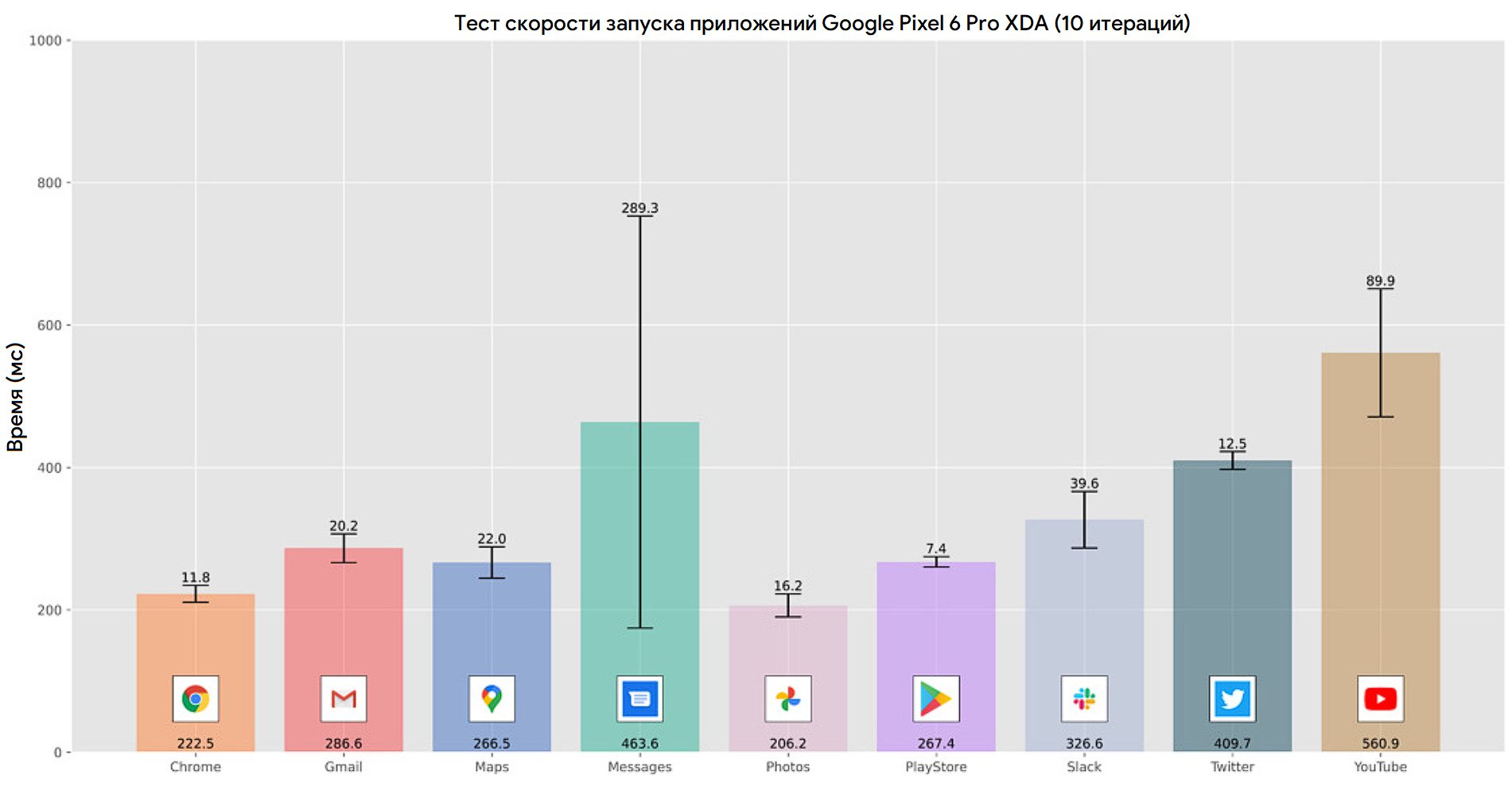
UI Smoothness Test
The Google Pixel 6 Pro has a 120Hz refresh rate display, but how well does the phone really support 120fps? My experience is that the Pixel 6 Pro runs incredibly smoothly, without a lot of microspots or noticeable frame rate drops. Although the phone drops the refresh rate to 60Hz when the video starts playing, I’ve tested scrolling on Facebook or Twitter and the video in the feed doesn’t drop the refresh rate to 60Hz . This means that you can flip through social networks and not constantly switch between 60 Hz and 120 Hz. If you do notice that this happens in applications, you can enable constant 120 Hz mode in the developer settings.
To see how well the Google Pixel 6 Pro can handle 120fps in real-world conditions, we ran a modified version of Google’s open-source JankBench benchmark. This benchmark mimics several common tasks found in everyday applications, including scrolling a ListView with text, scrolling a ListView with images, scrolling a grid with a drop shadow effect, scrolling with low bitrate text rendering, scrolling with high bitrate text rendering, typing and editing text from the keyboard, repainting with maps, and loading bitmaps. Our script records the draw time of each frame during the test, ultimately displaying all the frames and their draw times on the graph along with several horizontal lines.

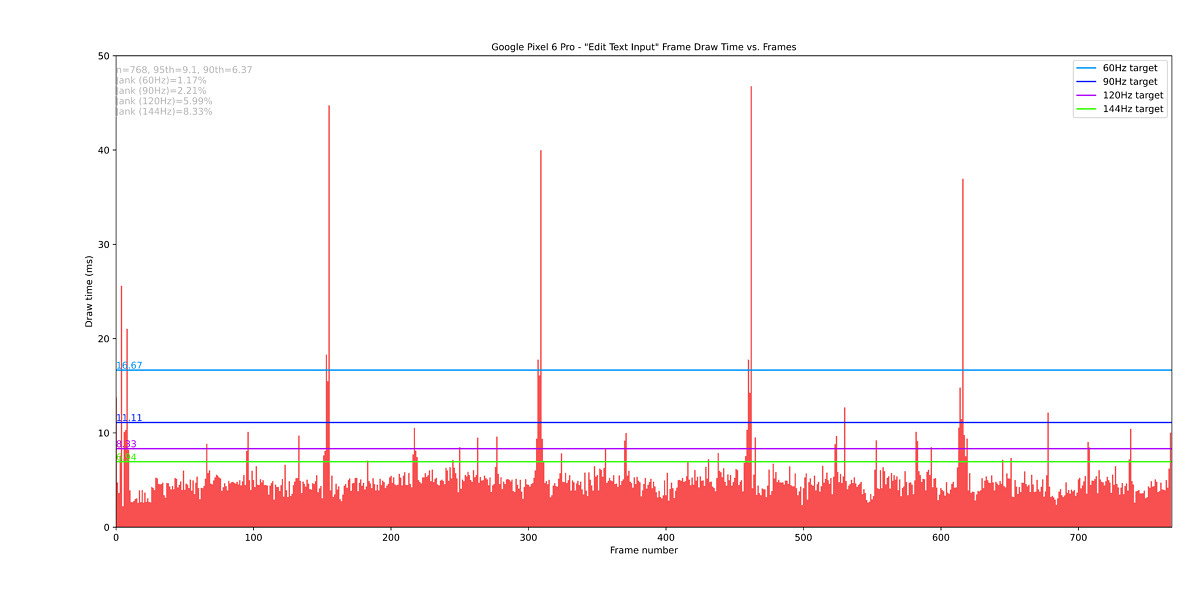
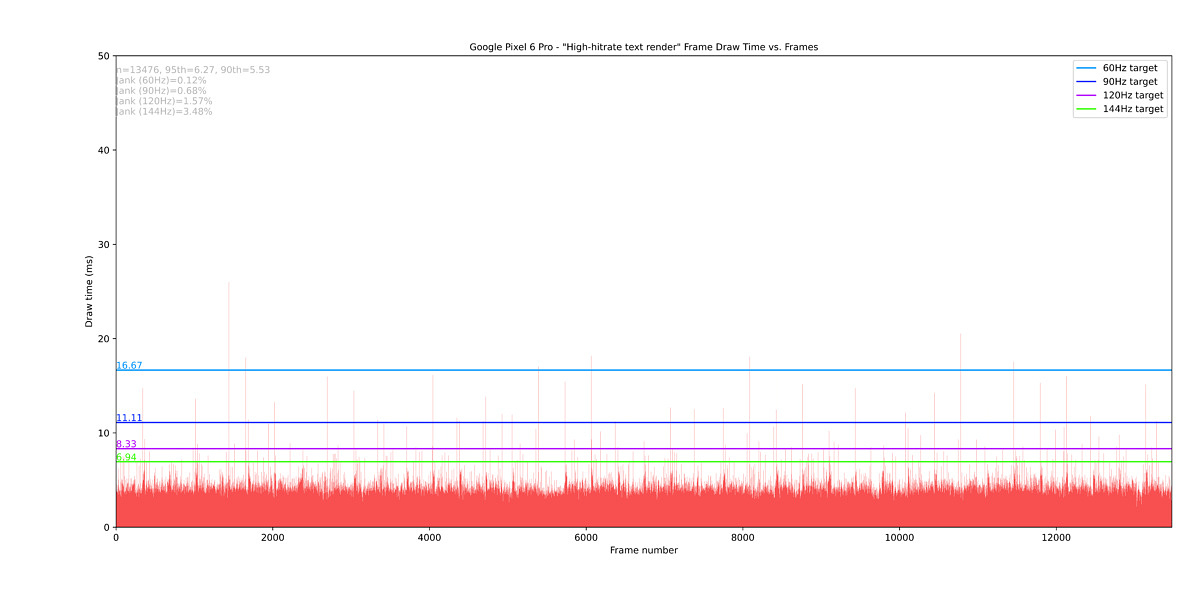
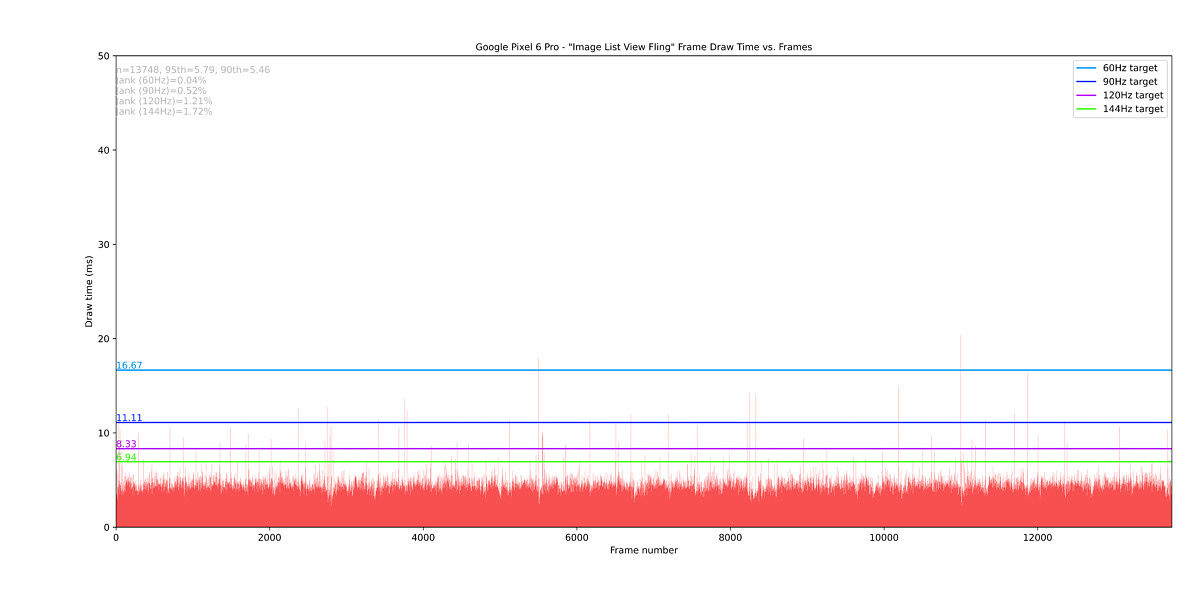

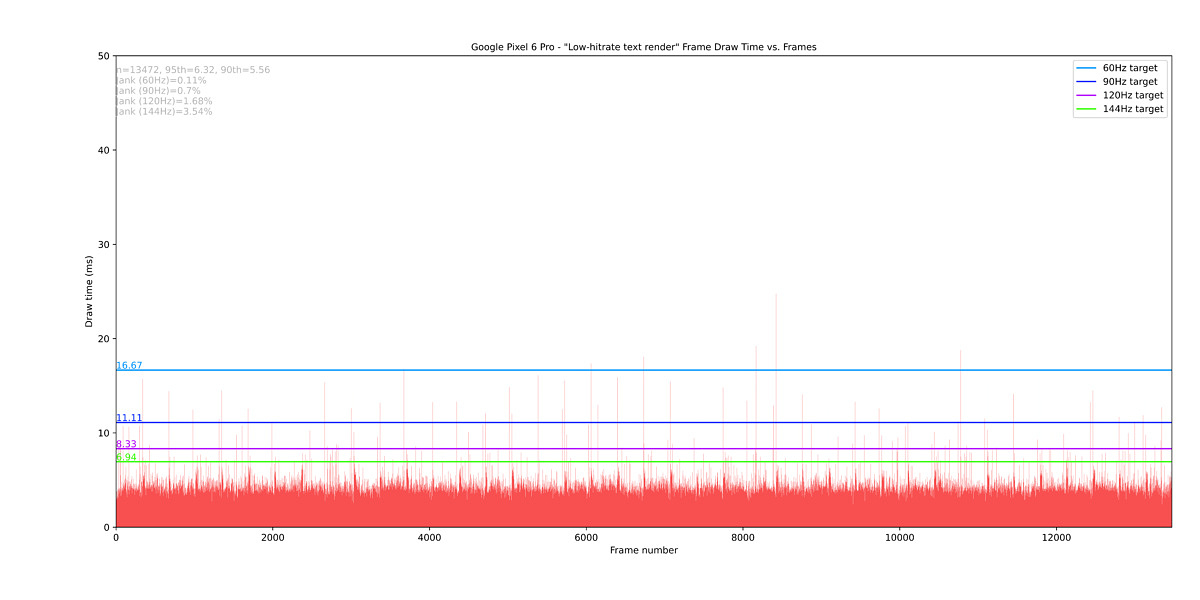
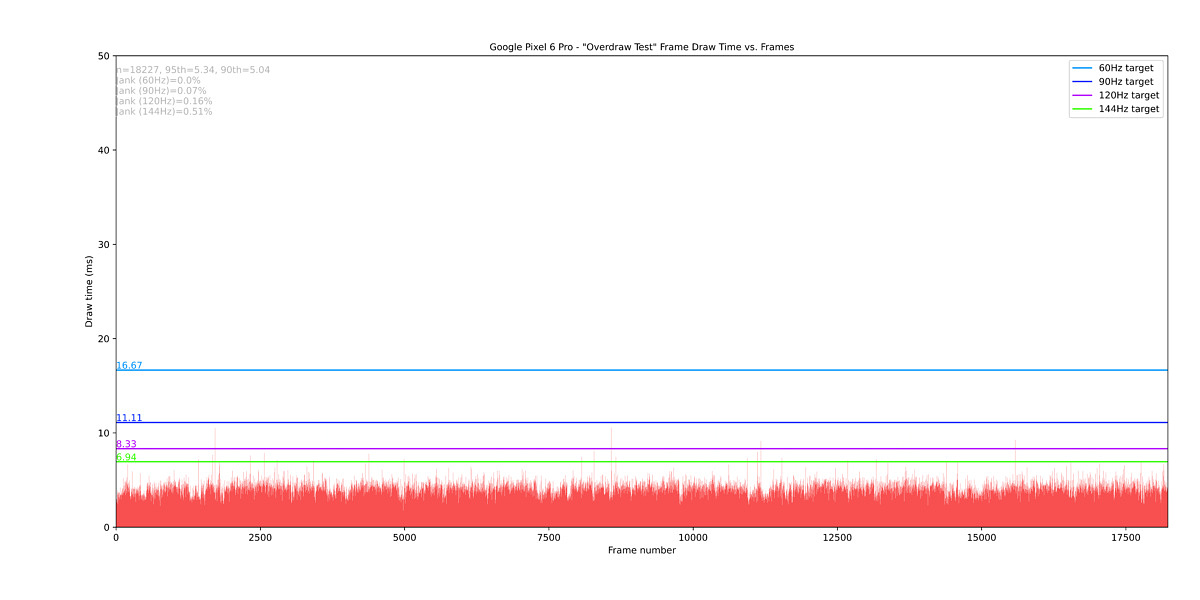
The results show that the Google Pixel 6 Pro is exceptionally fluid. The Google Pixel 6 Pro mostly supports 120Hz refresh rates, while the Xiaomi Mi 11 Ultra, for example, displays a lot of frames that can’t even be shown. The Pixel 6 Pro supports 120Hz pretty well, which means it’s actually a bit more productive, although it can drop below 120fps on more frequent occasions.
Long lasting performance and thermal performance
The Google Pixel 6 Pro performs well, but consistent performance is important too. The Google Pixel 6 Pro can get very hot, but I believe this is the result of the software. I found a number of software issues on my Google Pixel 6 Pro, and one of them – “com.google.android.gms.persistent” – is draining my phone’s battery. It turned out to crash sometimes after Chrome was left open in the background for a while, although I didn’t have enough time to check if that was the exact cause. Every time my phone started to heat up and the battery was running low, I noticed that this background process was consuming a lot of CPU resources. Other than that, thermoregulation was excellent, the phone periodically warmed up, but at the same time quickly dissipated heat through the glass back.
I ran the CPU Throttling Test to see how it handles consistent performance, and over time it started throttling a little. I was unable to get the actual temperature readings of the Google Pixel 6 Pro (CPU Throttling Test incorrect “Temperature: 50C”), but Ampere reports that the phone reached 40 ° C (104 ° F), but it was still used comfortable. It maintained a decent average of 190 GIPS (billion instructions per second), and throttled up to 75% of maximum performance in half an hour. This is a pretty good test and shows that the Google Pixel 6 Pro can withstand overheating and still perform well. I have never noticed any thermal throttling during normal use of the phone.

For comparison, take a look at the tests below. These are the throttling test results of OnePlus 9 Pro, OnePlus Nord 2 and Google Pixel 5.
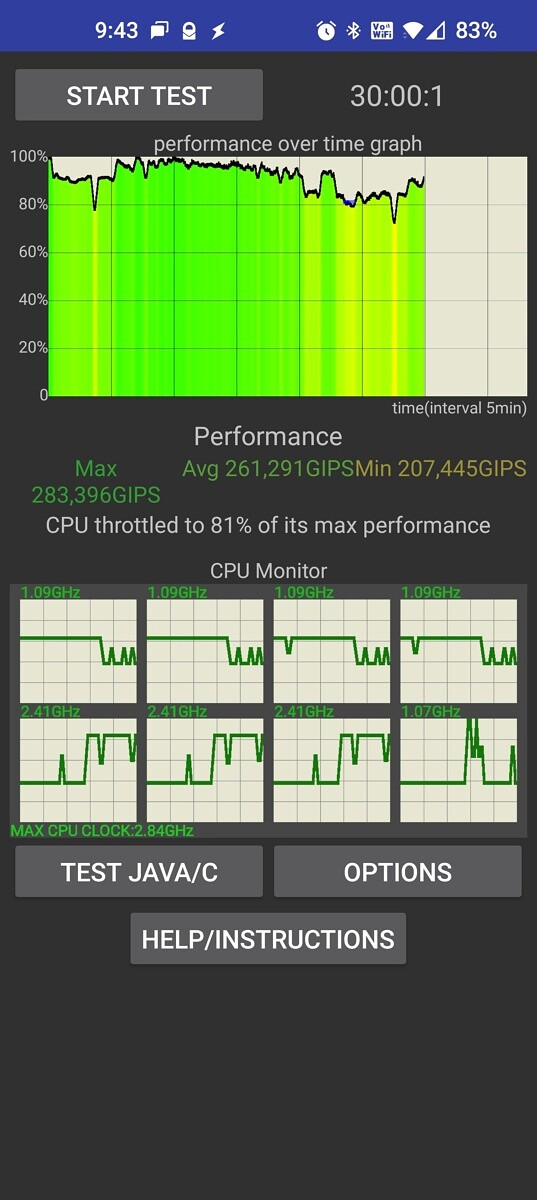
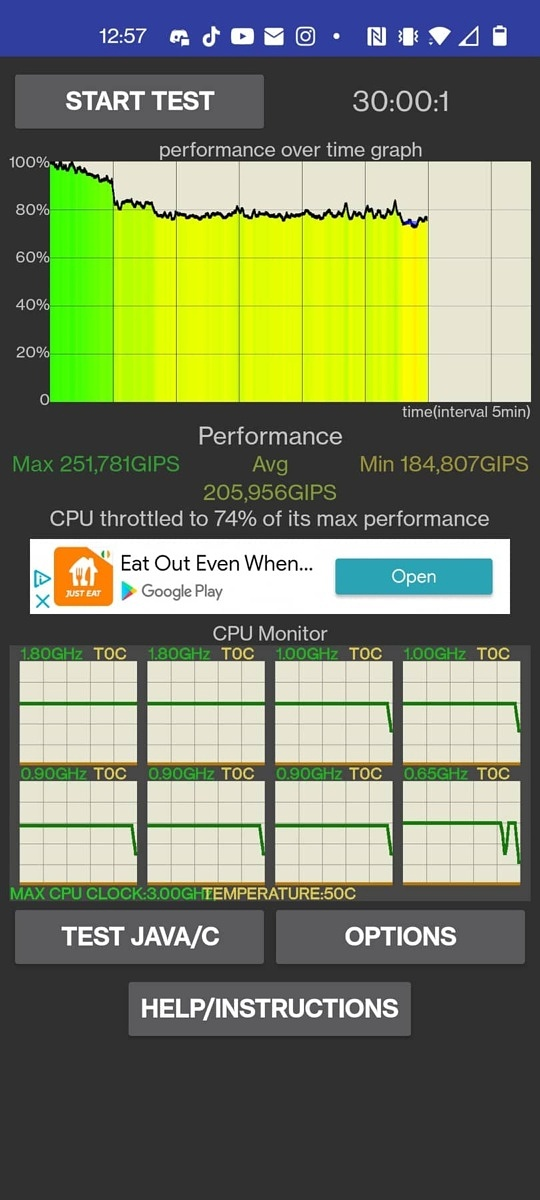

The Google Pixel 6 Pro beats the Pixel 5 completely and is on par with the OnePlus Nord 2 in terms of throttling performance. It is clear that the Google Pixel 6 Pro still lags behind the OnePlus 9 Pro in terms of throttling percentage, but it’s still quite a decent result.
I was confused by the aggressive thermal throttling and did further investigation by looking at the logs of the Google Pixel 6 Pro.
10-25 12: 14: 50.423 1566 1591 I pixel-thermal: usb_pwr_therm2: 39.719 degC I find aggressive thermal throttling is triggered around 39 ° C, although this is not too hot and may be the cause of some of the issues I have encountered. In comparison, in our review, the OnePlus 9 Pro reached 42.3 ° C under load. We need more time to investigate this issue, but the thermal performance of the Google Pixel 6 Pro causes problems under load, although overall it performs just fine under normal use.
Gaming Performance and Data Write Speed
Genshin Impact is one of the most demanding Android games, so I tested it on the highest possible graphics settings at 60 FPS. Severe drawdowns have always occurred on loading screens, and I tested the game at both 1440p and 1080p. Average FPS was much better at 1080p, but still struggled to achieve a stable 60 FPS.


We can see that the Google Pixel 6 Pro appears to be subject to a lot of thermal throttling in the case of the Genshin Impact, which I noticed in my own tests as well. As the phone warmed up, our test software also saw a decrease in power consumption, which means less power is being supplied to the CPU and GPU. Nevertheless, these results are respectable and perfectly acceptable if you are going to do light and casual games. You can slightly lower the graphical settings in Genshin Impact for a stable and smooth gameplay.
It’s also worth noting that in order to test Genshin Impact at 1080p max resolution, I needed to reduce the display size using adb. I used the following adb command to reduce the display size to 1080p. When playing at 1080p, the phone’s UI becomes unusable, so I don’t recommend doing that.
adb shell wm size 1080x2340 Games like PUBG and Call of Duty: Mobile run great and the emulation performance has been excellent as well. However, if games are your prerogative, then this phone is not for you, and you should pay attention to something like ASUS ROG Phone 5. It is not inferior to most modern flagships, and games like The Simpsons: Hit & Run in the emulator The Dolphins impressed me with their performance, although this phone is no match for gaming phones that have their own built-in cooling fans. Be aware that GPU Mali drivers will perform worse than Qualcomm Adreno drivers in emulation, although things are improving.
Interestingly, I ran 3DMark’s Wild Life benchmark and got a score of 6222. This is an intensive GPU benchmark that iPhones have dominated over the years and the Google Pixel 6 Pro is the best Android phone in terms of peak GPU performance. The Google Pixel 6 Pro should excel at gaming, but the apparent thermal throttling under heavy load degrades the experience significantly. Peaks are not an issue with the Pixel 6 Pro, far from it, long-term performance is an issue. Benchmarks should only be used as a guideline, but given that Google said it doesn’t pay much attention to benchmark performance, this is a particularly strong score for an Android smartphone.
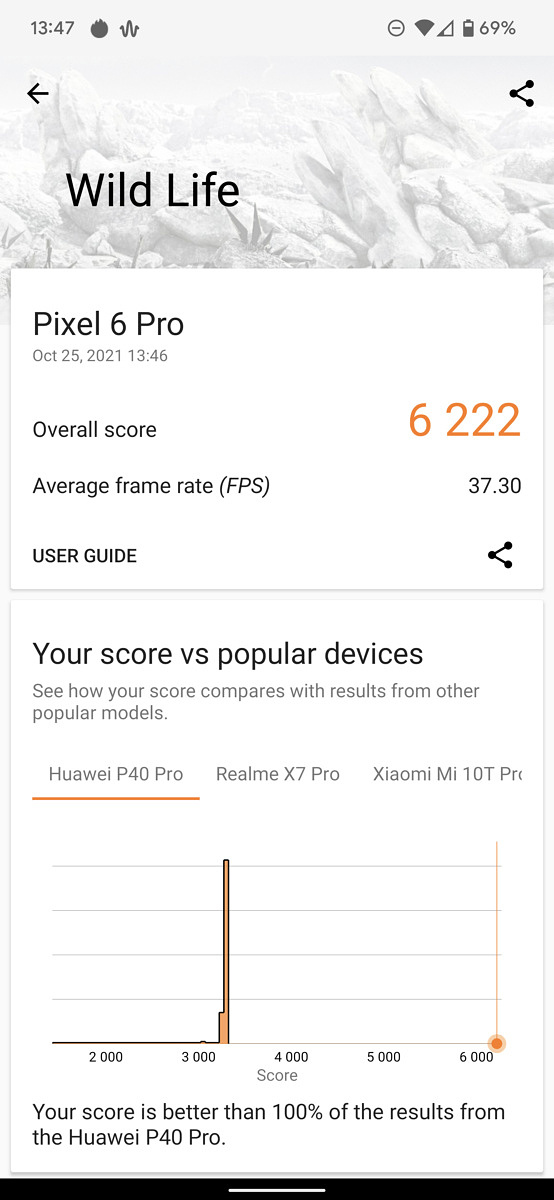
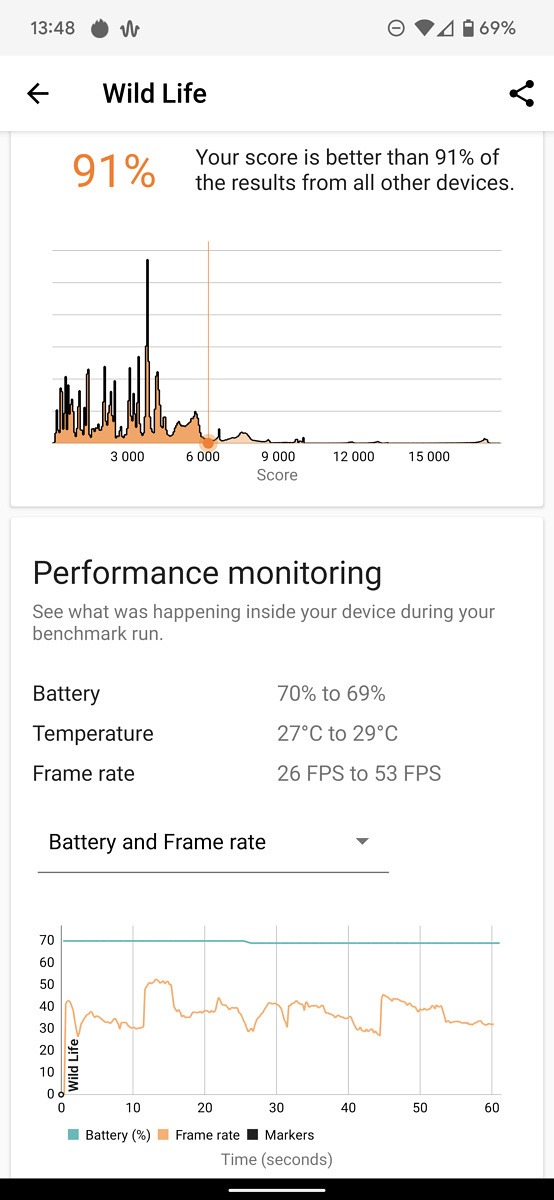
In terms of storage speed, the Google Pixel 6 Pro is similar to any other flagship launched in 2021. It’s UFS 3.1, which means you won’t have bottleneck problems when it comes to launching applications quickly.
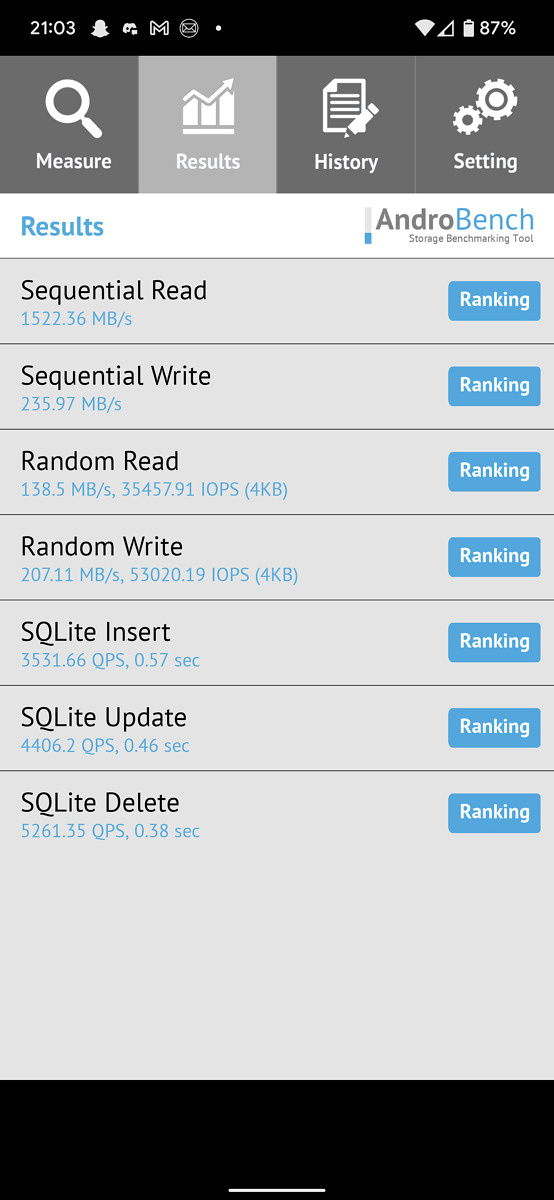
Battery Life & Charging
The Google Pixel 5 has set a very high bar for battery life, and it’s a shame to report that the Google Pixel 6 Pro is only doing average this time around. The battery life statistics in Android 12 only show data for 24 hours, not after the last charge cycle, but I would guess that I get about five hours of screen time every day. This is enough for me for almost an entire day of intensive use, but I definitely need to pay attention to the battery life of the phone in order to reduce the use time if necessary.
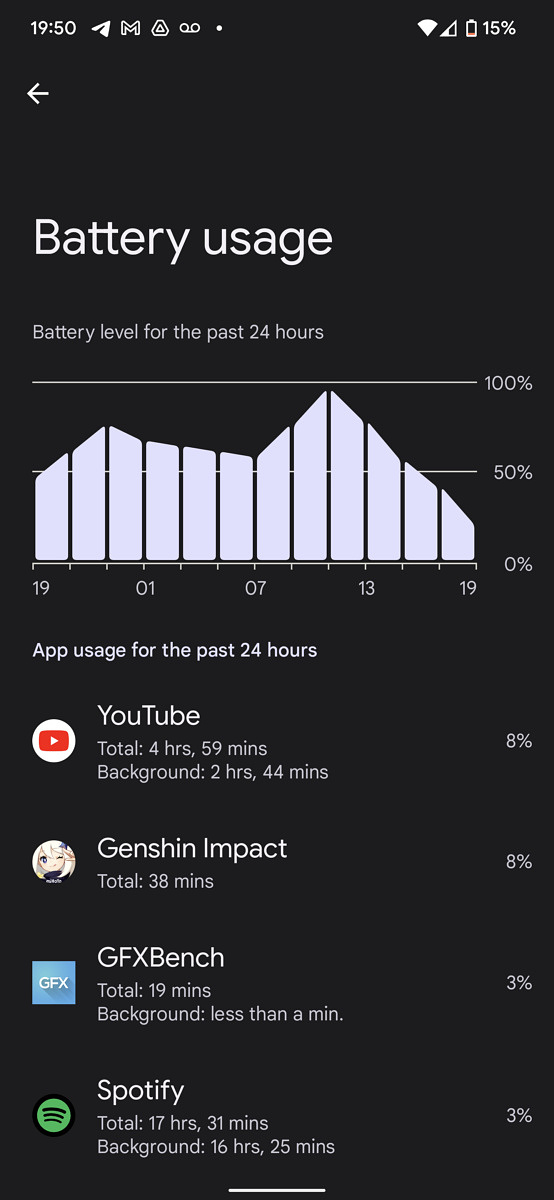

Charging time
The lack of fast charging is killing as the Google Pixel 6 Pro only supports 30W charging. The company claims that 50% charge is reached in half an hour, which is true, but it takes over an hour to fully charge the phone. Compared to the Xiaomi 11T Pro, which charges up to 70% in ten minutes, this is very frustrating.
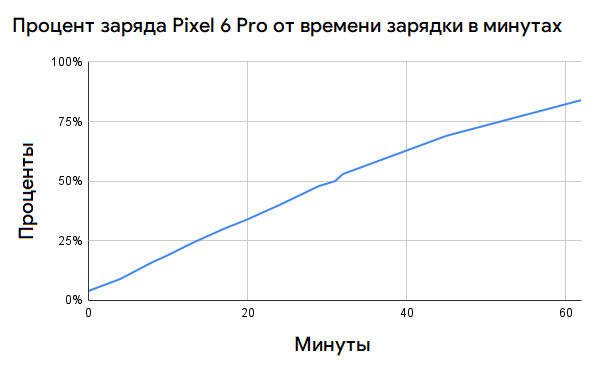
While I respect the adherence to a unified standard in USB Power Delivery support, this pill will be difficult to swallow when upgrading to the Google Pixel 6 Pro. It can be used, but don’t expect to charge it for 10 or 15 minutes and get a full day of battery life. It heats up a little while charging, but again, it doesn’t cause any discomfort.
However, I noticed a rather serious issue where the phone gets hot while charging. According to Ampere temperature monitoring, if the phone temperature gets above about 35 ° C (95 ° F), the battery charging rate is limited to 1A. This increases the charging time significantly and the only way to fix this problem is to cool the phone down. I started to put the phone on my metal laptop while it was charging to keep it cool, but this can sometimes be a major problem. The other day I was charging the phone while doing some background process, and after half an hour of charging, the phone’s charge increased by about 15%. I rebooted the device, after which everything was fine.
While charging rate limiting is fairly common in charging technology, this threshold is currently too low. 35 ° C is not that warm to the touch, and I guess most phones reach this temperature under load, especially if they are being charged. I hope Google raises this threshold a lot, because this is probably the worst aspect of the Google Pixel 6 Pro at the moment.
Wireless charger
The Google Pixel 6 Pro, like its flagship predecessors, supports wireless charging. The charging coil sits right in the center on the back and will work with just about any Qi-standard wireless charger you have at your fingertips. It supports charging up to 23W on the Pixel Stand 2. The charging coil is centered on the back of the phone, and this is where you can also do reversible 5W wireless charging. The reversible wireless charging function (called “Battery Share”) allows you to charge any Qi-enabled device and can be useful in a pinch. Unfortunately, I cannot enable this feature when the phone is connected to a charger, which is when I would use it the most.
Reviewed by Adam Conway , Senior Editor at XDA-Developers.
Original review
in English on XDA.

